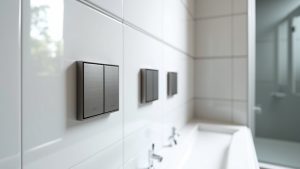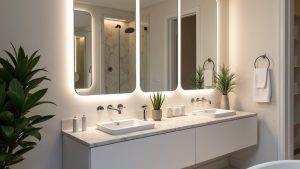To replace a bathroom fan light combo, start by turning off the power at the circuit breaker and verifying with a voltage tester. Next, remove the old fixture by disconnecting the wires and documenting their connections. Finally, install the new unit by securely mounting it, connecting the wiring, and testing the setup. Following these efficient steps ensures a successful installation. For further details on each stage, there is more information available.
Key Takeaways
- Turn off power at the circuit breaker and verify with a voltage tester before starting the replacement process.
- Remove the old fixture by unscrewing the cover and disconnecting wires, marking connections for reference.
- Install the mounting bracket for the new fan/light combo securely to the ceiling joists.
- Connect the electrical wiring using wire nuts, ensuring proper adherence to the original color coding.
- Attach the exhaust duct, install light bulbs, and restore power to test the new unit’s functionality.
Preparation and Safety Measures

Before beginning any bathroom fan light combo replacement, it is essential to prioritize safety and thorough preparation. Implementing safety precautions is critical; starting by turning off power at the circuit breaker and verifying with a voltage tester is non-negotiable. All wires should be treated as live, even when power is off. Utilize electrical tools with non-conductive handles and wear insulated gloves to minimize risk. Personal protective equipment (PPE), including safety glasses, dust masks, and work gloves, helps protect against debris and dust exposure. Additionally, confirm the compatibility with fan/light units by assessing the existing wiring to prevent issues during installation. Furthermore, ensure proper ventilation to reduce moisture hazards while working, as this can help maintain a safe environment. It is important to use ground fault circuit interrupters (GFCIs) in bathrooms to enhance electrical safety significantly. Additionally, it is advisable to match the replacement kit to original housing by make and model number to avoid compatibility issues.
A well-organized work area includes cleared surfaces and adequate lighting. Prepare for potential debris disposal and examine existing wiring and ductwork before installation. Such steps create a safe environment conducive to a successful replacement project.
Removing the Old Fixture

Removing the old bathroom fan light combo requires a systematic approach to ensure efficiency and safety. The process generally involves the following steps:
Removing an old bathroom fan light combo needs careful planning for efficient and safe execution.
- Cover Removal: Identify the cover type, whether it snaps in place or is secured with screws. Utilize proper tools like a screwdriver or flathead to detach the cover without damage.
- Motor Removal: Once the cover is removed, unplug the motor from the housing. Release any tabs or clips, and if necessary, unscrew the motor from the housing for complete removal.
- Electrical Disconnection: Always verify that wires are not live using a voltage tester before disconnecting. Mark wire colors and connections to simplify the installation of the new unit later. It is important to document existing wiring connections before removal to avoid confusion during the installation of the new fixture. Ensure the black wire from the switch is properly labeled for reconnecting during the new fixture setup.
Installing the New Fan Light Combo

With the old fixture successfully removed, the next step involves installing the new fan light combo.
First, verify that the ceiling opening accommodates the new unit; if not, adjust the dimensions using the manufacturer’s template.
After preparing the opening, the mounting bracket must be securely fastened to the ceiling joists.
Next, connect the electrical wiring: ensure power is off, pull the house wiring through the cable clamp, and link the fan and light wires to their corresponding house wires.
Use wire nuts for secure connections. For fan types with separate controls, ensure appropriate wiring.
After securing the fan housing, connect the exhaust duct, install the light bulbs, attach the grille, and restore power to test functionality.




